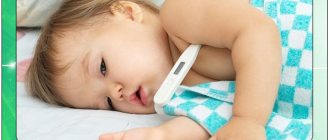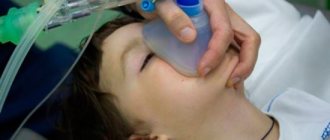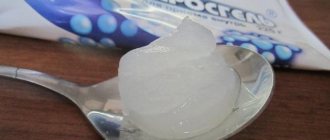Small children love to put unwashed hands or various objects in their mouths. It is almost impossible to keep track of them every minute. In addition, their body reacts sensitively to any low-quality products, food unusual for the stomach or toxins. In this regard, children often experience food poisoning, rotavirus and intestinal infections, various intoxications accompanied by vomiting, abdominal pain and diarrhea.
Vomiting and loosening of stools help the body rid itself of harmful substances and their toxins. And in addition to taking medications, the child must follow a special diet when vomiting, since the body needs to recover from the loss of beneficial minerals and trace elements.
To create the right diet for a baby and decide what to feed a child with vomiting and diarrhea in order to support a weakened body and restore normal functioning of the gastrointestinal tract, it is necessary to take into account the symptoms and manifestations of the disease - diarrhea, vomiting, or both at the same time.
Diet after poisoning in children: what you can eat, how to prepare food - sample menu
Food poisoning in children is quite common.
Intoxication occurs due to pathological microflora that enters the baby’s body along with food. The likelihood of poisoning increases sharply in the summer, when food storage rules are violated and food immediately spoils from the heat.
Sources of intoxication can be poorly washed fruits, cream cakes, fish and sausages, cottage cheese and dairy products, as well as dirty hands of the baby. An integral component of complex treatment after poisoning is diet.
After food poisoning, special attention must be paid to compiling a children's menu.
The digestive system in children is weakened after poisoning. There is a high probability of inflammatory processes in the pancreas and liver. To restore health, poisoned children must follow a strict diet for at least 2 weeks. To reduce the load on the damaged intestines, remove foods rich in fiber from the diet and limit fats.
READ ALSO: diet for diarrhea in a 2 year old child
Rules for feeding a baby after food intoxication:
- the consistency of the dishes should be soft or liquid, without solid inclusions;
- all food is stewed, boiled or steamed;
- food is served warm, hot food is excluded;
- fractional meals - 6 times a day in small portions;
- components that have an aggressive effect on the gastric mucosa are excluded;
- food is balanced in mineral composition.
During the period of acute poisoning, accompanied by vomiting, diarrhea and fever, the patient does not need to be fed. Just water and rehydration drinks are enough, you can add one cracker. The body must be completely cleansed of toxins.
When the acute stage of intoxication has passed and the obvious symptoms of the disease have disappeared, you can gradually introduce food in small portions. Rosehip decoction, lemon balm and chamomile tea are allowed (see.
See also: can a nursing mother drink rosehip infusion while breastfeeding?).
READ ALSO: What to feed a child if he is vomiting? Rosehip decoction suppresses inflammatory processes that occur during food poisoning and has a positive effect on the body’s recovery
In case of poisoning, it is important to maintain a drinking regime. On the first day, the body loses a lot of fluid due to vomiting and diarrhea, and dehydration begins. Water losses must be restored, so warm drinking is recommended - about 1.5 liters per day. You need to drink in small portions (infants - 3-4 teaspoons every 10 minutes), because Drinking too much can provoke a new attack of vomiting.
You can prepare a rehydration drink yourself: add a teaspoon of salt and sugar to 200 ml of boiled water, mix and drink the child.
Salt helps retain fluid in the body, and sugar replenishes energy losses. You can buy ready-made rehydration solutions in pharmacies.
During the recovery period, freshly prepared teas, jam drinks, rosehip and chamomile decoctions are recommended. Milk, carbonated drinks and juices are excluded.
On the first day after acute poisoning, only weak tea and lean cookies are allowed. A day later, chicken broth with breadcrumbs is introduced. All dishes should be served freshly prepared, not hot. The child's appetite may worsen, so there is no need to force-feed a sick baby and force him to eat large portions.
The basis of the diet after food poisoning should be light soups
After food poisoning, you can eat the following foods:
- Low-fat broths and soups. They should be fresh and without cabbage.
- Cereals (buckwheat, rice, oatmeal). Cook porridge in water, without using milk.
- Brown bread in the form of homemade crackers, dry biscuits.
- Stewed vegetables (carrots, cauliflower and broccoli, zucchini). Bananas and baked apples are good for the stomach. Boiled potatoes are allowed in small quantities.
- Dairy products: one-day kefir, yogurt (preferably homemade), yogurt. From the 3rd day, low-fat cottage cheese is introduced. Butter is added only to prepared dishes.
- Steamed eggs and stewed fish. Preference is given to low-fat varieties (pollock, cod, pike, navaga).
- Starch jelly from frozen fruits. Kissel envelops the gastric mucosa and promotes its restoration.
- Stewed or boiled meat (chicken, rabbit). It is advisable to chop the meat finely; it is best to prepare cutlets.
A balanced diet will allow the child after poisoning to effectively restore the vitality of the body and normalize the functioning of the gastrointestinal tract. There are foods that a child should not eat. Parents after food intoxication should pay special attention to this.
Excluded from the diet: white soft bread, pasta, pearl barley and barley, fresh milk, cheeses, fatty cottage cheese, sausages and frankfurters, pork, canned food, raw vegetables, pickled tomatoes, pickled cucumbers, citrus fruits, cakes, chocolate, nuts, soda , juices.
READ ALSO: barley porridge for mothers while breastfeeding
- Day 1 – sweet tea, jelly, homemade crackers from black bread.
- Day 2 – low-fat chicken broth with crackers, a little buckwheat porridge with water, jelly, dried black bread.
- Day 3 – mashed potatoes (do not add milk), chicken broth with half an egg, buckwheat, veal soufflé, baked apple, jelly. Meat soufflé can be replaced with a fish cutlet made from pollock or cod.
- 4th day - children begin to return to normal nutrition. You can have breakfast with semolina porridge on water or buckwheat, washed down with a glass of dried fruit compote. After a couple of hours, you should give your child a snack - a baked apple with a spoonful of jam or jelly with dry cookies. Lunch – a small portion of vegetables boiled in chicken broth. Steamed chicken cutlet. Afternoon snack – yogurt, cookies. Dinner – steamed omelette and jelly. Before going to bed, it is useful to drink rosehip decoction.
- Day 5 – continue to introduce new products, monitoring the reaction of the child’s body. For breakfast, you can prepare rice porridge in water with a spoonful of honey or jam, after a couple of hours - fruit vein or semolina pudding with jelly. Lunch – any chicken broth soup without cabbage, a portion of boiled pink salmon. Afternoon snack – low-fat cottage cheese, yogurt. Dinner – buckwheat porridge, chicken soufflé.
- From the 5th day, any dishes are prepared, excluding prohibited foods.
READ ALSO: What delicious things can you prepare for children for breakfast?
Diet after poisoning in children can prevent serious health problems. It is recommended to combine a properly balanced menu with the use of multivitamins, which will be prescribed by your pediatrician. Compliance with the above rules allows you to restore the normal functioning of the child’s body within a week after poisoning.
READ ALSO: Table No. 4 for children: diet features
Before we move on to answering the question of whether you can eat bananas for food poisoning, it’s worth talking about its symptoms.
It all starts with mild pain in the stomach. There may be a feeling of heaviness in the pit of the stomach. Then the pain intensifies and nausea is added to it. In severe poisoning, nausea turns into vomiting and diarrhea occurs. And all this against the backdrop of very severe stomach pain. The temperature rises and chills appear.
Vomiting does not bring relief, the intensity of its continuation is every 15-20 minutes. It exhausts a person. Lips become dry due to dehydration. But as soon as you drink a little water, the painful process repeats.
ethnoscience
Not many parents know that after vomiting you can eat not only regular foods, but also use traditional medicine recipes. Traditional medicine has proven itself well in the fight against many, even very serious, painful conditions. At home, you can try to prepare very healthy dishes and drinks that can stop vomiting and normalize the baby’s well-being:
- Peppermint tincture. 1 tbsp. l. raw materials must be brewed in 400 ml of hot water for at least 30 minutes. The bowl with the mixture should be wrapped in a warm blanket. The resulting liquid must be filtered and taken every 3 hours, 0.5 tbsp. l. in a warm form.
- No less popular is the infusion of lemon balm. To prepare it, 50 g of dried plant should be poured with 0.5 liters of boiling water and sent to a warm place for 60 minutes. The resulting drug should be given to the baby every 2 hours, 0.5 tbsp. l.
- If your baby is vomiting, you can give a remedy made from ginger root powder. A little crushed ginger root (on the tip of a knife) should be poured into 1 glass of warm water. You need to drink this product 1 tsp. 3 times a day. It will help get rid of nausea and vomiting.
- Pour 50 g of finely chopped valerian root into 400 ml of hot water and simmer over low heat for 15 minutes. and strain. You need to drink this liquid cold, 2 tsp. 2 times a day.
Never give your child any home remedies for vomiting without first consulting a doctor. In most cases, self-medication causes complications. Some homemade recipes can cause very severe allergies in your baby. Sometimes getting rid of allergies is much more difficult than getting rid of signs of poisoning.
Feeding a child after vomiting: what can and cannot be eaten?
After poisoning, the baby needs special nutrition. This will help him recover faster and improve his well-being. To promote a speedy recovery, you need to know what you can feed your child after vomiting, and what you should not give. The principles of nutrition depend on the age and time elapsed since poisoning. It is necessary to prepare food under special conditions.
Poisoning is not the only cause of the gag reflex. But in childhood, in most cases, it is precisely this that leads to food rejection and diarrhea.
What else causes not eating in childhood:
- intestinal infections;
- gastritis, ulcer;
- reflux;
- head injuries, high intracranial pressure;
- sun and heatstroke;
- appendicitis;
- CNS diseases;
You need to know what you can eat after your child vomits. But already during it, help should be provided.
Nutrition during an acute condition:
- An important component of first aid is maintaining a drinking regime. Diarrhea and fever increase fluid loss from the body. The balance needs to be restored. However, you should not force your baby to drink large amounts of water. This will cause more vomiting. You need to drink often and in small sips. The optimal break between drinking liquids is every half hour.
- Too cold or hot liquid is poorly absorbed by the body. Water from the refrigerator or just prepared tea will not save you from dehydration.
- Don't make your tea sweet. Sweets should be avoided.
- In addition to water, it is useful to drink unsweetened dried fruit compotes.
- Regidron or Humana helps restore balance.
Important! It is not recommended to feed your baby while vomiting.
It would be correct to find out what to feed your child after vomiting, depending on the time that has passed since it. On the first day, the body is not ready to accept heavy food. But gradually you need to restore your previous nutrition. This must be done correctly so as not to disrupt digestion.
Important! If there is bile or blood in the vomit, you should immediately consult a doctor!
First day
The child's nutrition after vomiting on the first day, when the symptoms of poisoning have not yet passed, should be minimal. The baby will not show initiative in eating, since there will be no appetite. While observing the principles of nutrition on the first day, you need to take into account the baby’s wishes.
How to feed your baby on the first day of poisoning:
- For the first day, be sure to maintain the norm of drinking water. Vomiting and diarrhea help remove pathogenic organisms from the body. At the same time, a person loses a lot of fluid and substances necessary for normal functioning. Doctors say that no liquid can replace clean drinking water. But children willingly drink juices and compotes. It is not recommended to give sugar on the first day. A rosehip decoction that is not sweet is suitable; it will also relieve nausea.
- In the first 6-7 hours, the minor should drink a moderate amount of water. Only then slowly reduce it. It is recommended to add salt to your drink.
- It is on the first day that Regidron or analogues are used.
- After 6 hours, you can include food in your diet. There should be 5-7 receptions, but in small portions.
- The baby is given biscuits, cream soup, and a baked apple. It is forbidden to eat raw vegetables, thick cereals, and dairy products. You can't drink fruit juices, even natural ones.
The second day after food rejection is accompanied by relief in the baby’s well-being. Appetite appears. There is an opportunity to diversify your diet. But parents still need to follow the diet. The body is not ready to return to its previous diet.
What to feed a child on the second day in case of poisoning and vomiting:
- On the second day, liquid porridge is given. Rice or wheat.
- Apples are allowed as fruit, but must be pureed. Vegetables only boiled. Carrots or broccoli.
- In addition to biscuits, the patient is given white bread crackers. It is recommended to soften them before feeding your baby.
- It is still allowed to drink dried fruit compotes and rosehip decoction. It is recommended to give chamomile tea, it soothes and has an anti-inflammatory effect.
Important! The next day after the exacerbation, appetite begins to improve. This is a sign that he is on the mend. If in the future the baby does not show a desire to eat, consult a doctor.
The menu on the third day is varied; the choice of food depends on the causes of indigestion. There is no need to give up your diet.
What to give your child on the third day after vomiting:
- Natural fruit juice is introduced into the diet. The purchased product must have a minimum amount of additives.
- You cannot return to the usual amount of food. With each dose, the portions are increased gradually.
- If the cause of the symptom is not poisoning, the child is given low-fat cottage cheese or natural yogurt. It is important that the dairy product is of high quality.
- Porridge is given in liquid form. Milk is added if there is no poisoning.
- Soups are given on a vegetable basis. They may contain small amounts of cereal.
- Jelly is added to the drink. It is important that they are not sour, as they will irritate the gastric mucosa.
- Fish and meat are given boiled. It is recommended to take low-fat varieties.
Dried fruit compotes remain on the menu. This is a source of essential vitamins. You can make jelly from rose hips.
On the fourth and fifth days after vomiting, the baby gradually returns to his previous diet. By this time, the stomach is ready to accept heavier food. These are ordinary soups, rice, buckwheat, fresh fruits and vegetables.
How to feed your baby on the fourth and fifth days after poisoning:
- 4 days after the acute period, the amount of food should be enough to satisfy the patient’s hunger. Portions are the same size as regular ones.
- Food should be low-fat. Any types of meat and fish are stewed or boiled.
- Drinks allowed are sweet tea and regular compotes. But it’s better to avoid sweet soda. It irritates the mucous membrane.
The baby's condition still requires close monitoring. The baby should be given as much food as he requires. But it is important not to lead to overeating.
It is important what to feed a child with diarrhea and vomiting, and how to prepare food.
It should be as easy, safe, and useful as possible:
- Food should be prepared without spices. A moderate amount of salt is allowed; it retains water in the body, which is necessary for recovery.
- You cannot fry foods. The optimal processing method is boiling, baking, steaming. In this case, heat treatment should be sufficient. The child's body is weakened and susceptible to pathogens.
- Before feeding your baby fruits or vegetables, you need to wash them well. It is recommended to remove the skin.
- In the first days, the products are crushed using a blender or other available method.
- The temperature should be comfortable and close to body temperature.
Important! Dishes must be fresh.
Food products should not irritate the gastric mucosa and promote its healing and restoration of microflora.
What can a small child eat when poisoning and vomiting:
- Cereals (oatmeal, buckwheat, rice).
- Lean meats.
- Lean fish.
- White bread.
- Processed vegetables.
- Fruits include banana and apple.
- After 3 days, kefir, yogurt, cottage cheese, higher-fat milk (if there was no diarrhea).
- Tea, rosehip decoction, dried fruit compote.
When poisoning occurs, you need to eat foods that are well digestible. Most of them can be immediately excluded from the list.
What not to feed your baby:
- Pearl barley, barley, millet porridge, legumes.
- Pasta products.
- Fatty meat, lard, sausages.
- Smoked products, canned food.
- Raw vegetables and fruits.
- Cookies, cakes, buns.
- Chocolate and other sweets.
- Fast food.
What to feed a child after a year when vomiting and after vomiting is easier to decide. What to do with babies under 12 months? At this age it is necessary to consult a doctor. Nutrition will depend on the type of feeding.
How to feed a baby up to one year:
- When breastfeeding, breastfeeding is given more often than before. But in small portions. This will promote better absorption.
- If it is necessary to switch to a mixture, the changes are made gradual.
- Complementary feeding is abandoned or portions are reduced.
- When bottle-fed, 7 meals are taken in small portions.
Doctor Komarovsky also answered mothers’ questions about what to feed their child immediately after poisoning and vomiting. He claims that the kids are given a special diet. If the condition is accompanied by fever, swelling and other symptoms, you should go to the doctor. In any case, hospitalization is recommended before the age of 3 years.
Nutrition tips:
- Do not give food during vomiting.
- Drink in small portions (2-3 sips), but often.
- Drinking temperature is room temperature.
- Add salt water, rosehip tea, and dried fruit compote to your diet.
- Take Enterosgel.
In case of vomiting, it is necessary to prepare dietary food for the child. It is based on a special drinking regime, the exclusion of heavy and irritating foods. It is necessary to increase portions gradually. If you are under 3 years of age if you vomit, you should definitely consult a doctor.
Vomiting in a child most often occurs due to food poisoning, but it can also be triggered by infectious diseases: scarlet fever, rotavirus.
There are other causes of vomiting: head injuries, severe stress, stomach diseases.
If a child vomits repeatedly, you need to show a doctor, otherwise dehydration can lead to undesirable consequences, including death. A proper diet after vomiting is also important.
If a child starts vomiting, it is better not to feed him during the first day. The digestive system needs time to recover.
But, if this is a one-time vomiting that appears due to severe stress, you don’t have to change your diet. When vomiting, a person loses a lot of fluid, especially if it is accompanied by diarrhea.
It is important to make up for this loss. Solder vomiting correctly:
- Don't force your baby to drink a lot of water. Drinking must be small and frequent. The child can drink just a few sips, this will be enough.
- Do not give him too cold or hot drinks; the temperature of the liquid should be the same as body temperature. Then the liquid will be well absorbed and dehydration will not begin.
- Do not put sugar, jam or other sweets, even honey, in your drink. If your baby refuses to drink water, give him juice, but before doing this, dilute it with water so that it becomes clear.
- Drink with solutions for oral rehydration: Regidron, Gidrovit, Gastrolit, the drug is prescribed by a doctor, mineral water without gas, dried fruit compote, weak tea, rosehip decoction.
Diet for day 2
Nutritional features of children under one year old
Children who are breastfed with complementary foods do not need additional nutrition during vomiting. Formula-fed babies digest rice and buckwheat mixtures with milk well.
Porridge made from buckwheat and rice is good for six-month-old children. They should be boiled in water and milk in a 1:1 ratio. Complementary feeding is allowed to be included in the baby’s menu after vomiting stops: this should be done gradually. The nutrition of a child aged 7-8 months requires the presence, in addition to porridge, of meat soufflé, vegetable puree, and fluffy cream soup.
Parents would be wise to trust the child's own needs and not put pressure on him regarding the quality and quantity of food. Let the baby eat as much as he wants and whatever he wants.
What to do?
It all depends on the condition. This condition can last up to three days, gradually losing intensity. As a rule, the first 1.5 days are the most painful. Then the urge to vomit decreases, as does the diarrhea. By the end of the third day you feel weak, but there are no obvious signs of poisoning.
The task of the sufferer during this period is to wash the stomach. Drink as much water as possible. You can drink a weak solution of manganese. Some people drink milk, but modern doctors believe that dairy products are not helpful during acute poisoning; it is better to limit yourself to water.
Is it possible to eat bananas, apples or vegetables if poisoned? No and no. During an exacerbation, you should not eat anything. If by the end of the second day signs of relief do not appear, you should call an ambulance.
Benefits of bananas
This yellow fruit is one of the few fruits that can be eaten during poisoning. Not at the moment of exacerbation, of course. Bananas are healthy, have a delicate taste, and are relatively cheap.
What are the benefits of bananas?
- High content of useful microelements. There is calcium, iron, and zinc, which are so necessary for the human body.
- Bananas contain a complex of vitamins B, A, C.
- Their most important advantage is that they are a natural antiseptic with a pleasant taste.
- Bananas have astringent properties, so doctors recommend them for problems with the gastrointestinal tract.
- Can children eat bananas if they are poisoned? Only in very small quantities.
Dish recipes
Meat soufflé
- Meat - 60 g;
- wheat bread - 5 g;
- egg -1/4 pcs.,
- butter - 1/2 teaspoon;
- broth - 1-2 tbsp. spoons.
Cut the meat, cleaned of films and tendons, into pieces and simmer in a small amount of water until half cooked. Then add wheat bread soaked in cold water, pass everything through a fine mesh meat grinder twice, add broth, egg and stir. Place this mass in a pan, greased with oil and sprinkled with breadcrumbs, and bake, covering the pan, in the oven in a water bath. Cooking time: 20-25 minutes.
Rice porridge with half and half milk
- Rice - 1.5 tbsp. spoons;
- water - 1 glass,
- milk - 1/2 cup, diluted half with water;
- sugar -1 tsp. spoon;
- butter -
- 1/4 teaspoon;
- salt - to taste.
Rinse the rice, add to boiling water and cook until soft. Then rub through a sieve, add hot (but not boiling) milk, stir well. Add sugar and cook for 2-3 minutes until the porridge thickens. Remove from heat, season with butter.
Contraindications
https://www.youtube.com/watch?v=_kIpR975lzM
Can you eat bananas after food poisoning? Those people who fall into one or more of the categories below should not eat these fruits at all:
- Presence of cardiovascular pathologies.
- Bananas are prohibited for diabetics due to their high glucose content.
- Bananas are a high source of potassium. If you overuse these fruits, you can provoke potassium hypervitaminosis.
- If the recovery process after intoxication is accompanied by vomiting, the fruits are excluded from the diet.
conclusions
The task of a children's diet for food poisoning is to restore the functioning of the intestines and support a weakened body. Rehabilitation can be long and difficult, but the recovery process can be accelerated by the right selection of products. Feed your child small portions, liquid (semi-liquid) food, follow a meal schedule and drink plenty of water. A balanced diet and a thoughtful menu will relieve unpleasant symptoms and replenish the deficiency of nutrients necessary for a complete recovery.
Video “Child’s diet after food poisoning”
To quickly restore digestion and improve well-being, it is necessary to improve the child’s nutrition after poisoning. In mild cases, the disease is often treated at home, so parents should take care of the correct menu and discuss the features of the daily diet with a specialist. This will help maintain the balance of nutrients and eliminate unpleasant symptoms such as intestinal upset.
Effect on the body
Can I have a banana after poisoning? Yes, but they are eaten only during the recovery period. And in the event that it is not accompanied by vomiting.
Bananas have the most positive effect on an exhausted body. As mentioned above, this is an antiseptic given to us by nature. When food poisoning occurs, bacteria enter the body and destroy the gastrointestinal microflora. An imbalance is created in the body. Sunny fruits kill harmful bacteria. Due to the fact that they have astringent properties, bananas relieve inflammation of the gastrointestinal tract.
When poisoned, many beneficial substances are washed out of the body. One of these is potassium. Sunny fruits are rich in beneficial microelements and vitamins, therefore they contribute to their restoration in the body.
Doctors advise that if you are poisoned by mushrooms, be sure to eat bananas. They help remove phenol from this type of intoxication.
If a child is poisoned
If we are talking about poisoning a baby, everything is much more complicated. Children begin to be capricious, and this is not surprising. The baby is in pain, scared and does not understand what is happening.
What do doctors say about children's menus in case of poisoning? During the recovery period, it is necessary to introduce very liquid soups and porridges with water into the diet. The body is growing, it needs food, which means there should be no energy restrictions. Rabbit meat and chicken are the best options for the protein component in a baby’s diet.
Children love sweets and can be capricious due to its absence. What can be replaced? Some kind of fruit? Can a child have a banana after poisoning? A child's body is weaker than an adult's. In general, bananas are allowed to feed children after poisoning, but it is better to consult a doctor about this.
Let's sum it up
- Refusal to eat in the first hours after vomiting is in itself a remedy. You cannot force a child to eat.
- After 6 hours, not earlier, you can offer him light food: jelly, white crackers, buckwheat or rice liquid porridge.
- It is recommended to gradually add boiled vegetables, as well as chopped meat and fish. All food should be warm and pureed.
- It takes from 5 days to several weeks to follow a therapeutic diet, depending on the severity of the disease.
Pediatrician of the 2nd category, allergist-immunologist, graduated from the Belarusian State Medical University of the Federal Agency for Health and Social Development. Read more », Rate this article: (4 rated 3.50 out of 5) Loading...Share with friends!
Introduction to diet
From what day can yellow fruit be included in the menu? From the third, if on the second day there is no vomiting. You need to start with a small amount. Bananas should be chewed slowly and thoroughly. On the first day after intoxication of the body, half the fruit will be enough.
Is it possible to eat bananas if you are poisoned? In small quantities it is possible. It is better to consume after the main meal. Eating a lot of bananas is prohibited.
The body is still weak, which means it is quite possible to go to the second round: vomiting, diarrhea and stomach pain. And no one needs this.
Poisoning: causes and consequences
Food poisoning is intoxication of the digestive tract due to consumption of spoiled or improperly prepared food. This type of infection is the most common case among one-year-old children.
The infection does not spread when using fresh, edible, properly prepared food. By observing proper care of the baby, personal hygiene, eating fresh vegetables and fruits washed in warm water and soap, the infection will not bother the baby. If the rules are not followed, harmful microorganisms enter the body with food:
- staphylococci;
- coli;
- Proteus;
- Klebsiella
When pathogens enter the immature microflora of a child’s body, they quickly spread, causing intoxication, salmonellosis, dysentery, escherichiosis, and other dangerous infections. The diseases are dangerous and, without appropriate treatment, lead to adverse consequences.
Symptoms of poisoning
Vivid symptoms of child poisoning:
- sharp pain in the stomach;
- sudden deterioration in health;
- pale complexion;
- diarrhea;
- increased body temperature;
- nausea;
- frequent vomiting.
The baby feels very sick and has diarrhea. The temperature may rise or fall. The described symptoms require immediate medical attention. Symptoms may occur at normal temperatures.
When the disease worsens, children have no appetite, Dr. Komarovsky recommends constantly giving the child water-salt solutions, compotes, and jelly to drink.
When restoring digestion, the properties of foods absorbed by the body are taken into account. Wrong nutrition will lead to indigestion.
Diet after poisoning in children: what you can eat, how to prepare food - sample menu
After poisoning, gentle nutrition is necessary. At least for one week. The menu is given below. As well as the answer to the question of whether you can eat bananas if you are poisoned.
| Day of the week | Breakfast | Dinner | Afternoon snack | Dinner |
| Monday | Rice porridge with water, rosehip infusion | Chicken broth with homemade wheat croutons, weak tea | Half a banana | Oatmeal jelly |
| Tuesday | Buckwheat porridge with water, weak tea | Chicken broth with grated carrots, rice water | Rosehip decoction with wheat crackers | Half a banana, weak tea |
| Wednesday | Grated banana, biscuits, weak tea | Rice pudding, steamed chicken cutlet, rosehip infusion | Kissel and baked apple | Rosehip decoction, a little semolina porridge in water |
| Thursday | Chicken broth with pasta, rice broth | Vegetable stew, boiled chicken breast, rosehip infusion | Banana and a cup of weak tea | Soup – vegetable puree, rose hip decoction or plain water |
| Friday | Baked cheesecakes, decoction of compote mixture | Vegetable soup with oatmeal, a piece of boiled fish, weak tea | Crackers, banana, jelly | Steamed chicken cutlet, rosehip decoction |
| Saturday | Semolina porridge on water with banana, weak tea | Soup – pumpkin puree, baby turkey puree, apple and pear broth | Biscuits, jelly | A piece of boiled chicken breast, rosehip infusion |
| Resurrection | Buckwheat porridge with a piece of chicken, weak tea | A little mashed potatoes without milk, a piece of baked fish, tea or weak fruit drink | Baby beef puree, rosehip decoction | Millet porridge with banana, jelly |
After a week-long diet, you can carefully introduce other foods into the menu. In this case, you should listen to your body and observe the reaction of the gastrointestinal tract to new food. If your stomach starts to hurt again or the urge to vomit makes itself felt, you will have to go on a diet a little longer.
As for products such as marinades, smoked foods, salty, fatty and fried foods, you will have to temporarily forget about them.
https://www.youtube.com/watch?v=0c2-3AeliEc
Is it possible to eat bananas if you are poisoned? As we can see from the table with an example menu, it is possible. In the first days, it is advisable to consume no more than half a fruit per day. Starting from the third day, introduce a whole banana into your diet.
How to choose the right products
It is easy to encounter an infection at any time of the year. Therefore, parents should know not only what their child can eat after poisoning. Adults should learn to carefully select good quality foods that will benefit the whole family:
- It is better to refuse to purchase frozen semi-finished products, which rarely contain high-quality meat.
- Don’t be shy about smelling fillets or fish and asking for documents confirming their freshness.
- It is better to choose domestic fruits and vegetables that are in season and do not contain pesticides and nitrates.
- Be sure to pay attention to the expiration date, the composition on the label, and the safety of the packaging.
- It is recommended to buy baby purees in glass containers and inspect the consistency and color of the product.
It is strictly not recommended to purchase meat or milk from your hands. Often food poisoning is diagnosed after visiting cafes or eateries. Therefore, on long walks you should take with you homemade crackers, biscuits or banana, and a thermos with tea or fruit juice.
Vomiting is a natural reaction of the body to poisoning. In children, it occurs when they eat low-quality food or food that the body cannot digest. Vomiting can also occur as a reaction to elevated temperature. In this case, it will stop as soon as the fever subsides. After you have managed to cope with vomiting, you need to take care of proper dietary nutrition to help the body overcome the consequences of poisoning. Diet is especially important in case of vomiting accompanied by diarrhea, because this can lead to dehydration. What to feed a child after nausea, how to support a weakened body?









